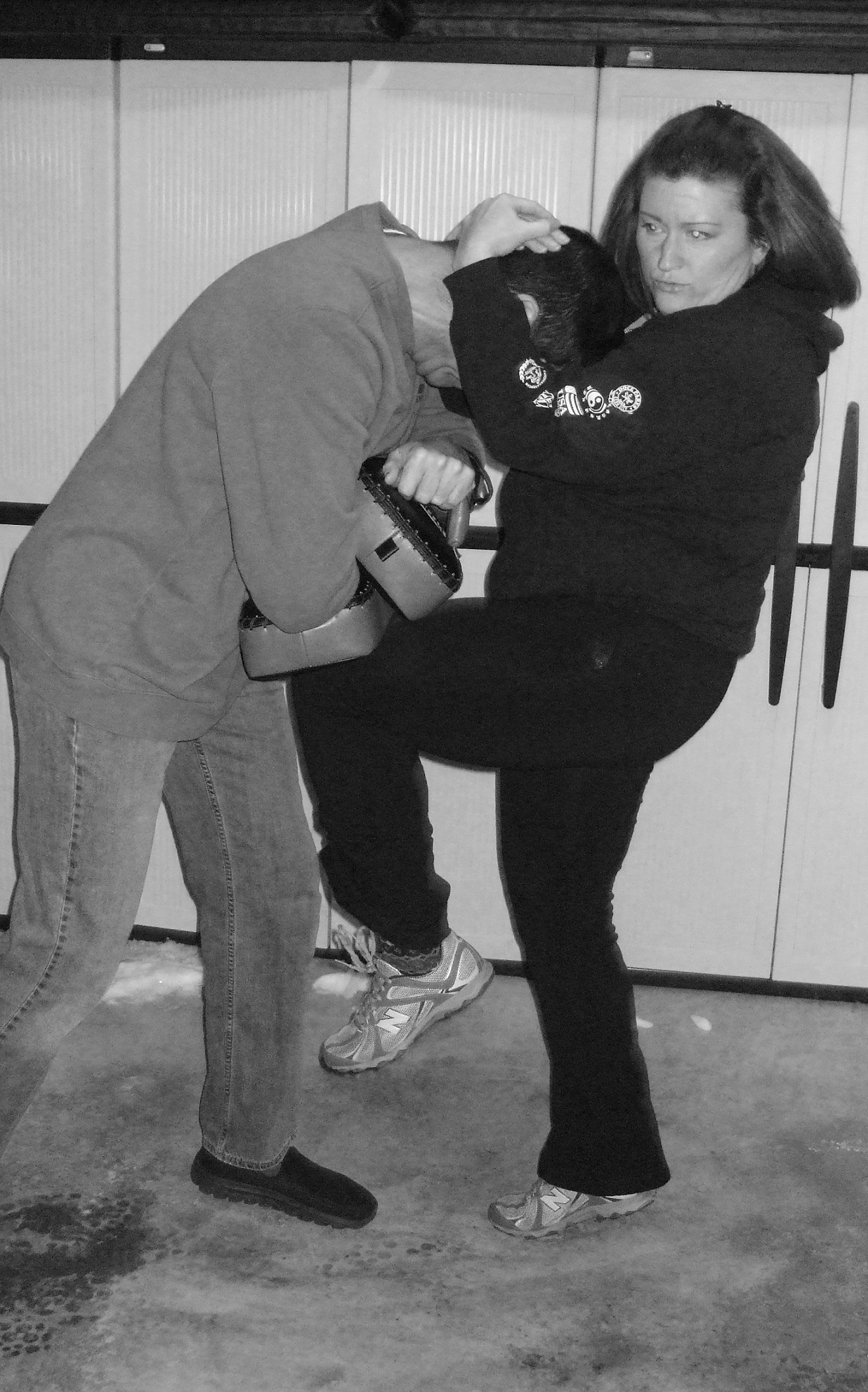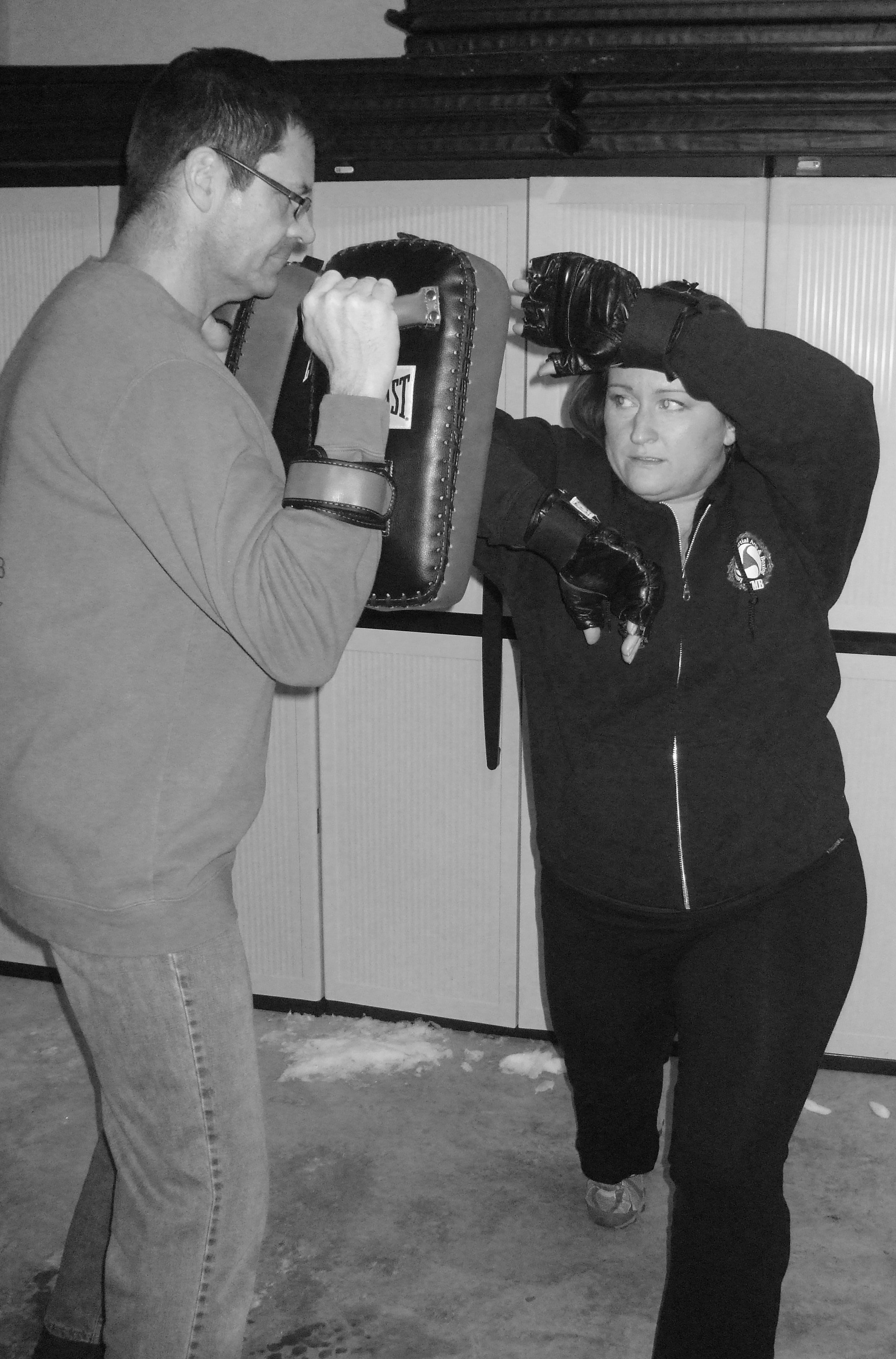
Knees alone can be painful. But adding the hips as you follow through the move will increase the pain, allowing for less frequent and more powerful blows. Photo: courtesy author
Why is it important to spend time talking about the hips? First of all, it’s the second largest weight-bearing joint in the body (second only to the knee). When you think of how much stress and pressure your body gives your hips simply by walking, let alone any type of load-bearing training, you might have a better appreciation for understanding how to take care of them and also use them properly. Your hips provide stability and mobility throughout your day, mostly without your even thinking about them. But when something doesn’t “feel right,” you notice. Pain and dysfunction can occur in joints both above and below the hips, pain that could require medical attention.
Biomechanics of the Hips
The hip joint is a ball-and-socket joint. Movement, hip and leg flexion, extension, adduction, abduction, and internal and external rotation are essential parts of its function. The hips also affect the connecting areas such as the lumbar spine and knee as well as the more distant opposite shoulder or elbow. I’m sure at some point you’ve had mystery pain in your shoulder or down the back of your leg. It may have been from your hips!

The kick is a good example of the quick burst of hip movement that provides maximum effectiveness. Photo: courtesy author
Training and Practice
This is important because it validates the need for proper training in using your hips as a power source in unarmed defense. Improper training could lead to either small or large injuries, which could put your training on hold. In another article, I will outline a few drills that will help strengthen your hips and surrounding muscles. I’ll also go into a few training techniques using the hips as a power source. But for now, I’ll outline the safest order in which to practice any technique using hip strength.
Let’s back up for just a minute. As much as I believe that the hips are the best power source for unarmed defense, I also believe a person should never sacrifice precision or speed for power. The sloppy “smash ‘em” mentality of some is hardly a method that deserves mention. Dirty fighting – yes, there is a place for that in personal defense. But if you’re going to train, start with precision, add speed, and finish with power.

Hips are extremely important when throwing elbows to generate additional power when in close proximity to your target. Photo: courtesy author
Precision
As with anything, the more precise or accurate your physical movements are, the better the results. Depending on the move you are performing, your hips will turn in a certain direction when you do it correctly. If your hips don’t move optimally, your execution will not be as effective as it could be, and that could be the difference between getting out of a bad situation and having it escalate. In order to eliminate the variables that would prevent you from having a positive outcome, you need to practice precision drills (over and over and over. . .). Precision practice is also the surest way to guard against unnecessary injuries. Of course, any time you are working with body mechanics, you run the risk of injury, but precision drills will assist you in proper body movement so you don’t torque, twist, or pop your way into couch-potato mode for a few weeks.
Speed
Once you have the correct body movement with your hips, the next element to work is speed. The speed at which your hips rotate, move forward, etc will enable you to generate the power needed to deliver a debilitating blow to your attacker. It also enables you to beat your attacker to the punch in the attack (no pun intended). Speed drills are necessary but might be tricky at first. Start at a moderate pace and work your way up to a faster pace. In doing so, you ensure that you are working the drill correctly, in turn creating the proper body movement for instilling “muscle memory.” Once you are able to increase the speed of the drill, you will see how it not only positively affects the defensive move, but you should also recognize the increase in reaction time as well as the flow into the next move and the next one. And remember, finishing the move (bringing the arm, leg, knee, or elbow back to the original position or setting up for the next one) should be just as fast if not faster than the delivery.

Hips allow for added power at the end of the punch, regardless of type (jab, cross, hook). Photo: courtesy author
Power
Now that you have taken the time to practice your precision and speed, the power should almost naturally follow. Repetition using the proper form while adding speed will assist and should provide results that show increased power. But there are also additional movements with the hip that can make your strike even more powerful. I suggest ending your strike with a sudden and deliberate burst of energy in your movement. For example, we’ve all hit the baseball a time or two, right? You’re at bat. Feet positioned, knees bent, arms up, and hands gripping the bat. As you swing and the bat connects with the ball, your hips have that sudden burst of movement as you follow through with your swing. That’s what I’m talking about. That sudden burst of movement in the follow-through motion from the hip should be at the end of every unarmed defensive move to create maximum effectiveness.
Conclusions
The pictures included in this article show four very specific unarmed defensive moves that if done correctly require hip strength and power to deliver an effective strike. Can they be done without proper hip movement and power? Sure. But the difference would be like comparing someone speaking in a normal voice to someone shouting at the top of their lungs with the extra force coming from their diaphragm. You hear the words in both scenarios, but one most certainly has a more lasting effect on the recipient.
It’s important never to take our bodies for granted. If you think of your body as the weapon that carries the debilitating force with which to defeat your attacker, then you by all rights treat it like you would any other defensive weapon. The arms, elbows, knees and legs are merely a delivery system for the power created by the rest of your body, mainly the hips. Take time to take care of the power behind the delivery. Your opponents will hate you for it!
Even though this article is old it is still excellent and worth studying. Lots of detail that can easily be missed. Julie's point of pulling the striking body part (hand, knee, elbow) back is critical and very often forgotten in a piece like this - kudos Julie. Strike, reset, strike, reset... until the assailant stops. Which of these moves do you use? The assailant will decide by their actions.
What unarmed self-defense system/martial art you recommend for defense?
I am a black belt self-defense instructor in Kajukembo, America's first mixed martial art, as well as a Certified Personal Trainer and I could not be more pleased with this article. This is exactly what I teach every single day... It's all in the hips baby... Chris Garner Abilene, Texas